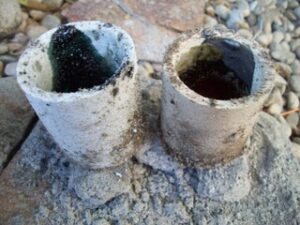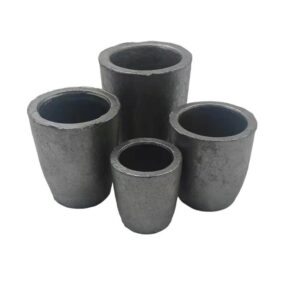Welcome to our guide on how to clean a graphite crucible! If you work with high-temperature materials, you know that a clean crucible is essential for accurate and consistent results.
In this article, we’ll walk you through the steps to properly clean your graphite crucible, so you can get back to producing reliable and high-quality results. Let’s get started!
How to clean a graphite crucible
As a high-temperature container used in various industries, it’s important to keep your graphite crucible clean to ensure accurate and consistent results. Here’s a step-by-step guide on how to clean your graphite crucible:
- Allow the crucible to cool: Before attempting to clean your crucible, make sure it has cooled down to a safe temperature. Handling a hot crucible can result in burns or other injuries.
- Remove any large debris: Using a pair of tongs or a crucible tong, carefully remove any large pieces of debris or residue from the crucible.
- Scrape the crucible: Using a brass or stainless steel scraper, gently scrape the inside of the crucible to remove any stuck-on residue. Be sure to use a light touch to avoid damaging the crucible.
- Clean the crucible: Once you have removed as much residue as possible, you can clean the crucible using a mild detergent and warm water. Gently scrub the inside of the crucible with a soft brush to remove any remaining debris.
- Rinse and dry the crucible: Rinse the crucible thoroughly with clean water to remove any soap or residue. Then, dry it off with a clean cloth or paper towel.
By following these steps, you can effectively clean your graphite crucible and maintain its performance. Just be sure to handle the crucible carefully and avoid using harsh chemicals or abrasive materials, as these can damage the crucible or leave behind unwanted residues. Happy cleaning!
How do you clean carbon out of a crucible?
To clean carbon out of a crucible, you can follow these steps:
- Allow the crucible to cool: Before attempting to clean the crucible, make sure it has cooled down to a safe temperature. Handling a hot crucible can result in burns or other injuries.
- Remove any large debris: Using a pair of tongs or a crucible tong, carefully remove any large pieces of debris or residue from the crucible.
- Scrape the crucible: Using a brass or stainless steel scraper, gently scrape the inside of the crucible to remove any stuck-on residue. Be sure to use a light touch to avoid damaging the crucible.
- Clean the crucible: Once you have removed as much residue as possible, you can clean the crucible using a mild detergent and warm water. Gently scrub the inside of the crucible with a soft brush to remove any remaining debris.
- Rinse and dry the crucible: Rinse the crucible thoroughly with clean water to remove any soap or residue. Then, dry it off with a clean cloth or paper towel.
By following these steps, you can effectively clean carbon out of your crucible and restore it to good working condition. Just be sure to handle the crucible carefully and avoid using harsh chemicals or abrasive materials, as these can damage the crucible or leave behind unwanted residues.
How are stains removed from a crucible?
There are several methods you can use to remove stains from a crucible. Here are a few options to try:
- Scrape the stains: Using a brass or stainless steel scraper, gently scrape the stains off the surface of the crucible. Be sure to use a light touch to avoid damaging the crucible.
- Use a mild detergent: Mix a small amount of mild detergent, such as dish soap, with warm water. Use a soft brush to scrub the stains, and rinse the crucible thoroughly with clean water to remove any soap residue.
- Use a mixture of vinegar and salt: Combine equal parts vinegar and salt to create a paste. Spread the paste over the stains and allow it to sit for a few hours. Then, use a soft brush to scrub the stains, and rinse the crucible thoroughly with clean water.
- Use a commercial cleaner: There are various commercial cleaners specifically designed for cleaning crucibles. Follow the manufacturer’s instructions for use, and be sure to rinse the crucible thoroughly with clean water to remove any residue.
By following these steps, you should be able to effectively remove stains from your crucible. Just be sure to use caution and avoid using harsh chemicals or abrasive materials, as these can damage the crucible or leave behind unwanted residues.
Does vinegar dissolve carbon build up?
Vinegar can help to dissolve carbon build up in certain situations. The acetic acid in vinegar is a strong enough to dissolve carbon, but the effectiveness will depend on the type of carbon build up and the concentration of the vinegar.
To use vinegar to dissolve carbon build up, you can create a mixture of equal parts vinegar and water and apply it to the affected area. Allow the mixture to sit for a few hours, and then scrub the area with a soft brush to loosen and remove the carbon. Rinse the area thoroughly with clean water to remove any vinegar residue.
Keep in mind that vinegar may not be effective at dissolving all types of carbon build up, and it may not work as well as other methods such as using a commercial cleaner or scraping the build up off with a brass or stainless steel scraper. It is also important to use caution when using vinegar, as it can damage certain materials if left on for too long or used in high concentrations.
Why should a crucible be washed before drying it?
It is important to wash a crucible before drying it because washing helps to remove any debris or residue that may be present on the surface of the crucible. This can include material that was used in the crucible, as well as any contaminants that may have come into contact with the crucible.
If a crucible is not washed before drying, these substances can remain on the surface and potentially affect the quality of future samples or experiments. For example, if a crucible was used to melt a certain type of metal, residual metal can be left behind on the surface of the crucible. If this metal is not removed and the crucible is used for a different purpose, it can contaminate the new sample and affect the results.
By washing the crucible before drying it, you can help to ensure that it is clean and ready for use, and avoid any potential contamination or interference with future experiments.
How do you condition a graphite crucible?
Conditioning a graphite crucible is a process that helps to prepare the crucible for use by removing any impurities or contaminants that may be present on the surface. Here’s how to condition a graphite crucible:
- Clean the crucible: Follow the steps outlined in the previous answer to clean the crucible and remove any debris or residue from the surface.
- Heat the crucible: Place the crucible in a furnace and heat it to a temperature of about 1000°C (1800°F). This will help to evaporate any remaining contaminants or impurities on the surface of the crucible.
- Allow the crucible to cool: Once the crucible has reached the desired temperature, turn off the furnace and allow the crucible to cool down to room temperature.
- Repeat the process: It may be necessary to repeat the heating and cooling process several times to fully condition the crucible. The exact number of times will depend on the condition of the crucible and the type of materials it will be used with.
By following these steps, you can effectively condition your graphite crucible and prepare it for use. Just be sure to use caution when handling the crucible and the furnace, and always follow proper safety protocols.
Wrapping Up
In conclusion, cleaning a graphite crucible is an important step to ensure accurate and consistent results in your high-temperature experiments or processes. By taking good care of your crucible, you can avoid contamination and ensure that your samples and experiments are of the highest quality.
Other cleaning guides
How To Clean Skateboard Grip Tape – Best Methods


